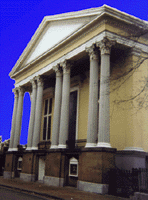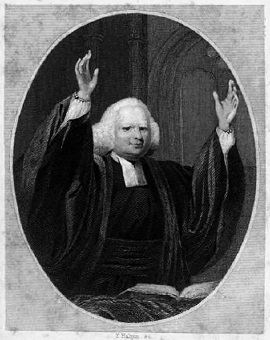Old Pine Street Presbyterian Church

"The Church of the Patriots"
Old Pine Street Church is the only pre-Revolutionary Presbyterian structure still standing in Philadelphia. What was intended in 1768 to be a modest "chapel of ease" for the city's First Presbyterian congregation, is today a prodigious Greek-revival edifice. Formidable Corinthian columns and a pair of giant doors anchor the Church's north side while the rest of the temple is enveloped by an old cemetery replete with rows of tilting tombstones that lend a Charles Addams touch to the scene. Belying the mood, however, is the Church's cheerful canary-colored exterior which only hints at the beauty to be found within.
On the day Reverend George Duffield came to preach in 1771, though, cheerfulness was in short supply.
But first we must fall further back in time to 1704, the year the First Presbyterian Church of Philadelphia, nicknamed "Old Buttonwood," was built.
Just 35 years later, George Whitefield first came to call in Philadelphia. Whitefield was the most influential of the prophets of the Great Awakening. Others in the movement included Jonathan "Sinners in the Hands of an Angry God" Edwards in New England and Gilbert "the Terrors of the Lord" Tennent in New Jersey and Philadelphia.
The Great Awakening was highlighted by a wave of religious revivalism in the Colonies during the mid-1700s. Led by these spellbinding sermonizers, the movement sought to emphasize brotherhood and the plight of the poor.
Playing on fear and stirring passion, Whitefield harangued individuals into being empathetic, charitable, and socially responsible. His message appealed to those who were alienated from their various churches and to the democratic-minded who responded to Whitefield's call for Humanitarianism.
At the First Presbyterian Church in Philadelphia, the Great Awakening led to a rift: the "Old Lights" were content with the status quo and the "New Lights" were drawn to the oratory and message of Whitefield.
Shortly after hearing Whitefield preach, "New Lighters" came together to build a church on Arch Street — the Second Presbyterian Church. The minister there was none other than the aforementioned Gilbert "Hell-fire" Tennent.
Over time, enthusiasm for the Great Awakening waned and by 1759 there was a reconciliation between the "Old Lights" and "New Lights."
Though differences still existed concerning the taking of oaths and other theological matters, political concerns, such as talk of American Independence and of a swell in immigration, confronted them. At that time, the First Presbyterian Church was ministered to by Francis Alison and John Ewing.
WE INTERRUPT FOR A FEW WORDS ABOUT ALISON AND EWING
To the list of extraordinary Colonial Philadelphians we must add the names of these two Doctors of Divinity.
In addition to being a minister, John Ewing was a brilliant mathematician. A committee of scholars of which he was a member charted the transit of Venus in 1769. He helped fellow mathematician David Rittenhouse survey the Mason and Dixon line. He became first Provost of the University of the State of Pennsylvania and was a member of the American Philosophical Society. In addition, once the Declaration of Independence was signed, Ewing would offer no prayers to George III.
Francis Alison has been called the greatest classical scholar in the Colonies. He was Vice-Provost of the College, Academy, and Charitable School of Philadelphia, and, like Ewing, a member of the American Philosophical Society. Plus, to his glory or censure, he founded the first life insurance company in the colonies, "The Corporation for the Relief of Poor and Distressed Presbyterian Ministers." Using money from the Ministries, Alison sponsored missions to proselytize Native Americans living on the frontier.
BACK TO OUR STORY
Alison, recognizing that Old Buttonwood could no longer accommodate the swell of Presbyterian immigrants, arranged for a new church to be built as a satellite of the First Church. In 1764, Alison purchased a plot of land from William Penn's sons Thomas and Richard. The site they chose was coincidentally, where George Whitefield gave a public sermon and is what is today called the Old Pine Street Presbyterian Church.
The original church, a rectangular brick Georgian structure, was designed by Robert Smith, who was born in Scotland (as were many of the Church's congregants) and was one of Colonial America's foremost master builders, or architects. Those who visit St. Peter's, Christ Church, Ben Franklin's home, or Carpenters' Hall on their virtual walking tour will become better acquainted with the venerable builder's work.
Initially it was Dr. Alison who preached here. The first pastor hired by Alison was Samuel Aitkin, a strong supporter of American Independence. Though well liked, Aitkin resigned the Pastorate owing to a scandal in his first year. Some historians claim that the firebrand Aitkin could not control his passions when it came to his future wife. She delivered a baby six months after they were married. Alison, an "Old Light," returned to preach until 1771 when our story finally returns to the day George Duffield came to town.




